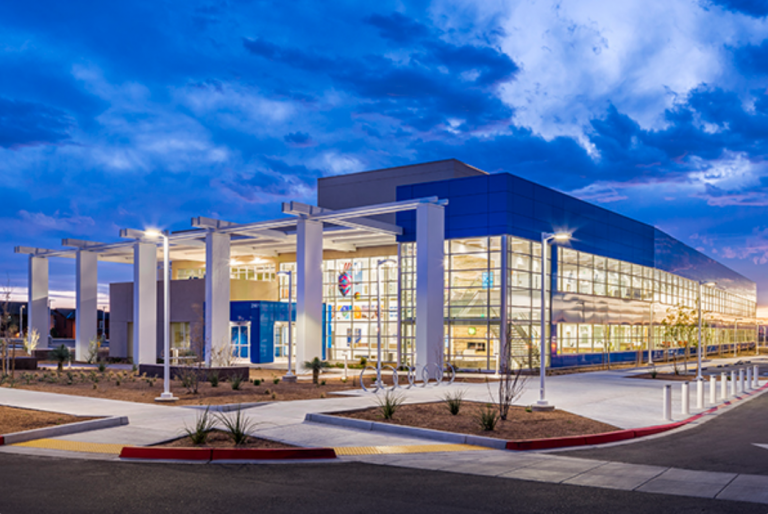The MMRE Portfolio should whet the appetites of today’s hungriest, largest investors
Name: MMRE Portfolio
Number of buildings: 17
Square feet: 813,467
Location: 9 states
Seller: Montecito Medical R.E.
Occupancy: 96.9%
Investment grade: 40%
Lease structures: Triple net
Brokerage: CBRE
Brokers: Christopher R. Bodnar, Lee Asher, Sabrina Solomiany, Ryan Lindsley

The Montecito Medical Real Estate (MMRE) Portfolio consists of 17 medical office buildings (MOBs) in nine states with a total of 813,467 square feet. (Photo courtesy of CBRE)
Coming off what could be called the “year of the portfolio” for medical office building (MOB) sales in 2017, 2018 also looks as if it will be rife with some substantial portfolio offerings and sales as well.
After four sizeable portfolio sales kicked off the year during the first quarter (Q1), two new large offerings hit the market in mid-April.
One is the Elliott Bay Healthcare Portfolio, a collection of 91 single-tenant healthcare properties with a total of 1.02 million square feet of space in 25 states. The properties were acquired during the last five years or so by Seattle-based Elliott Bay Capital Trust. The brokerage team representing the seller is the Healthcare Capital Markets team with Chicago-based Jones Lang LaSalle (NYSE: JLL).
The other big offering is the one being featured here: the MMRE portfolio, which consists of 17 medical office buildings with a total of 813,467 square feet of rentable space in nine states. Representing the seller is the U.S. Healthcare Capital Markets Group with Los Angeles-based CBRE Group Inc. (NYSE: CBG).
MMRE stands for Brentwood, Tenn.-based Montecito Medical Real Estate, a private equity firm that has acquired – both on its own and with investment partners – more than 100 properties for a total of about $1.7 billion since its founding in 2005.
As we have noted numerous times in recent years on the pages of Healthcare Real Estate Insights™, the MOB sector continues to attract new, large and institutional investors to the product type. These large investors prefer to acquire MOBs in portfolios, especially those that are occupied by credit-rated tenants.
In addition to offering a buyer “instant scale” in the MOB sector, the MMRE portfolio provides what the healthcare group with CBRE calls long-term stability and income growth, with the portfolio yielding $18.59 million of annual in-place NOI and $18.75 million in pro forma NOI. That income, according to CBRE, provides an “investor the opportunity to mitigate pursuit costs with a single transaction.”
The CBRE team is led by Lee Asher and Chris Bodnar, long-time healthcare real estate (HRE) sales specialists and vice chairman with the company. They are joined by (??)
They note that the portfolio is not only 96.9 percent leased, but that 40 percent of the space is occupied by investment grade credit-rated tenants.
Those credit rated tenants include Des Moines, Iowa-based UnityPoint Health, Akron, Ohio-based Summa Health, Cleveland Clinic, Crawfordsville, Ind.-based Franciscan Health, St. Louis-based Ascension Health, and others. CBRE adds that additional tenants include what the brokerage firm calls “prominent” regional physician groups.
In addition to the health system tenants, the MOBs in the portfolio house what CBRE calls “some of the most dominant physician groups in their markets.” About 49 percent of the portfolio’s square footage is occupied by such groups.
A number of the physician groups occupying space in the portfolio, according to CBRE, are “potential acquisition targets by health systems, providing an opportunity for a future owner to benefit from a significant increase in direct hospital occupancy.”
The portfolio has an average remaining lease term of 10.47 years, with only 3 percent of the total tenancy expiring in the next four years, according to CBRE. The portfolio’s properties are in California, Arizona, Utah, New Mexico, Mississippi, Tennessee, Ohio, Indiana and Iowa.
The average age of the assets is 7.9 years, CBRE says, adding that the properties were “developed by high-caliber construction firms and in many instances designed and developed on behalf of the providers that occupy the space.”
– John B. Mugford
The full content of this article is only available to paid subscribers. If you are an active subscriber, please log in. To subscribe, please click here: SUBSCRIBE





